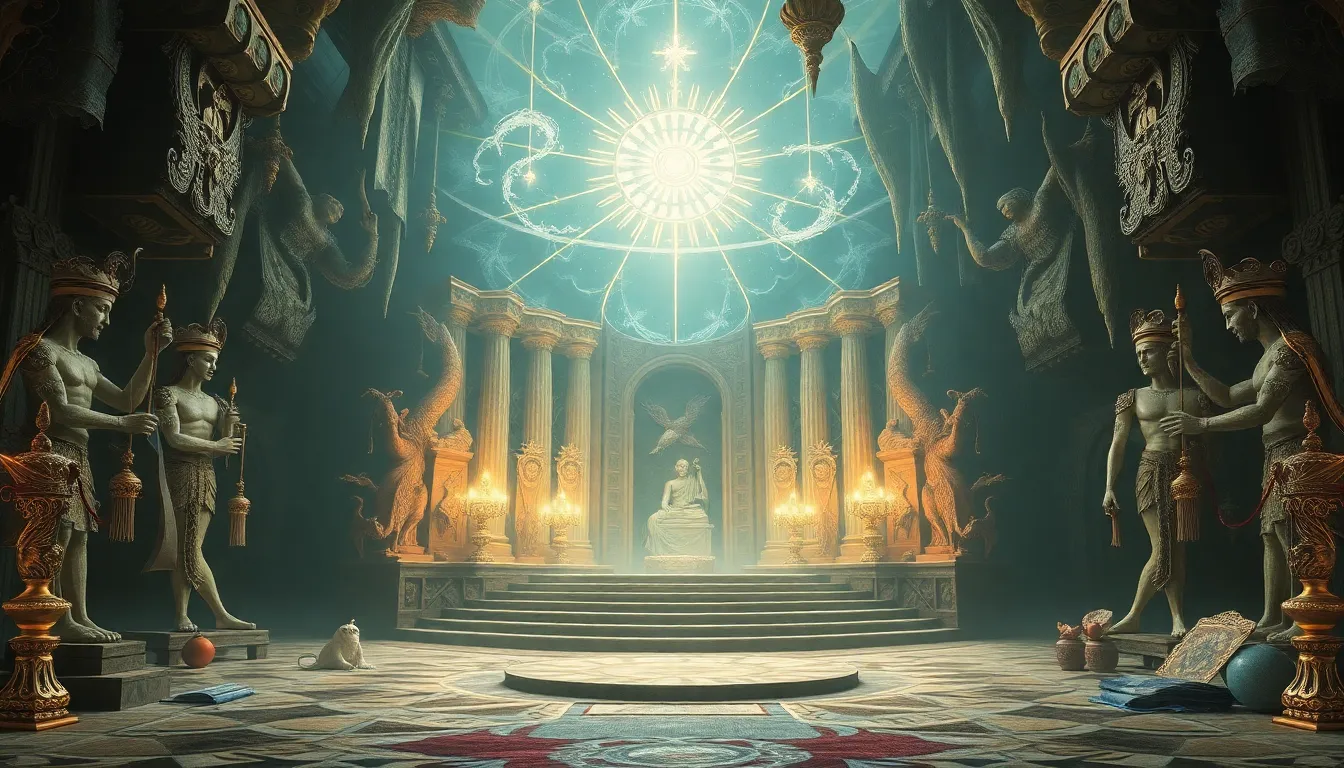The Divine Sanctuary: Where Myths and Reality Meet
I. Introduction
A Divine Sanctuary can be defined as a sacred space where the divine presence is believed to dwell, serving as a bridge between the mortal world and the divine. These spaces have been revered throughout history, often becoming centers of worship, pilgrimage, and cultural identity.
The intersection of myths and reality within these sanctuaries unveils a rich tapestry of beliefs, practices, and narratives that shape human understanding of the sacred. This article aims to explore the multifaceted dimensions of divine sanctuaries, examining their historical context, myths, architectural significance, and the psychological impact they have on individuals and societies.
II. Historical Context of Divine Sanctuaries
A. Ancient civilizations and their sacred spaces
In ancient civilizations such as Mesopotamia, Egypt, and Greece, sanctuaries played a crucial role in religious and social life. Temples dedicated to gods were often built on elevated ground or in locations deemed sacred, symbolizing their proximity to the divine.
B. Evolution of the concept of sanctuary through ages
As societies evolved, so did the concept of sanctuary. From the grand temples of the ancients to the humble shrines of modern spirituality, these sites have adapted to cultural shifts, reflecting changing beliefs and practices.
C. Cultural significance in different societies
Divine sanctuaries are not just places of worship; they serve as cultural hubs. They foster community, preserve traditions, and provide a sense of identity. In many societies, they are seen as vital links to the past and the divine.
III. Myths Surrounding Divine Sanctuaries
A. Origin stories and their roles in various cultures
Myths often explain the origins of divine sanctuaries. These narratives provide insight into how different cultures understand their relationship with the divine. For instance, many believe that certain sanctuaries were chosen by the gods themselves.
B. Prominent myths associated with famous sanctuaries
- Delphi: Home to the Oracle of Delphi, where it was believed that the god Apollo spoke through the Pythia, offering prophecies to seekers.
- Jerusalem: The Western Wall and the Dome of the Rock symbolize deep spiritual significance and are steeped in religious history and myth.
C. The role of deities and supernatural beings in these narratives
Deities often play central roles in the myths surrounding sanctuaries. They are seen as protectors and patrons of these sacred spaces, influencing the rituals and practices that take place within them.
IV. Architectural Marvels: The Physical Manifestation of Sanctuaries
A. Iconic examples of divine sanctuaries around the world
Across the globe, various architectural marvels serve as divine sanctuaries:
- The Parthenon in Athens, dedicated to Athena.
- The Great Mosque of Mecca, a central site for Islamic pilgrimage.
- The Templo Mayor in Mexico City, a significant Aztec sanctuary.
B. Architectural styles and their meanings
The architectural styles of sanctuaries often reflect the beliefs and values of the cultures that built them. For example, Gothic cathedrals with their pointed arches and flying buttresses symbolize the aspiration towards the divine.
C. The symbolism embedded in sanctuary design
Many sanctuaries incorporate symbolic elements in their design, such as:
- Light and space that represent the divine presence.
- Water features that symbolize purification and renewal.
- Specific orientations that align with celestial events, enhancing spiritual significance.
V. Pilgrimage and Rituals: Bridging the Gap Between Myth and Reality
A. The significance of pilgrimage in various religions
Pilgrimage to divine sanctuaries is a universal practice that transcends cultures and religions. It symbolizes a journey of faith, reflection, and often, a quest for healing or enlightenment.
B. Ritual practices associated with divine sanctuaries
Rituals performed at these sites can vary widely but often include:
- Prayer and meditation.
- Offerings and sacrifices.
- Festivals and communal gatherings.
C. Personal testimonies and experiences of pilgrims
Many pilgrims report profound experiences during their journeys to sacred sites, often describing feelings of connection to the divine and transformative moments of clarity.
VI. The Psychological Impact of Belief in Divine Sanctuaries
A. How myths shape human perception and understanding of reality
Myths surrounding divine sanctuaries influence how people perceive their place in the universe and their relationship with the divine, often providing comfort and meaning in times of uncertainty.
B. The role of faith and spirituality in individual lives
Faith practices associated with sanctuaries often serve as a foundation for individuals’ spiritual lives, providing a sense of community and belonging.
C. Psychological effects of visiting sacred sites
Research indicates that visiting sacred sites can lead to increased feelings of peace, reduced anxiety, and a greater sense of purpose.
VII. Modern Interpretations of Divine Sanctuaries
A. Contemporary spiritual movements and their relation to ancient sanctuaries
Modern spiritual movements often draw inspiration from ancient sanctuaries, seeking to revive or reinterpret ancient practices in contemporary contexts.
B. The role of technology in reshaping the experience of sanctuaries
Technology has transformed how people engage with divine sanctuaries, from virtual tours of ancient sites to the use of social media to share experiences.
C. Case studies of modern sanctuaries and their appeal
Modern sanctuaries, such as the Lotus Temple in India or the Peace Pagoda in Japan, encapsulate contemporary spiritual ideals, often attracting visitors seeking solace and reflection.
VIII. The Intersection of Science and Myth
A. Archaeological discoveries that challenge or support myths
Archaeological findings often provide evidence that supports or challenges the myths surrounding divine sanctuaries, offering new insights into their historical relevance.
B. The role of science in understanding historical sanctuaries
Scientific methods, including carbon dating and architectural analysis, help reconstruct the historical significance and cultural context of these sacred sites.
C. Bridging the gap: how science and myth can coexist
Rather than being in opposition, science and myth can coexist, with each offering unique perspectives on human experience and understanding of the divine.
IX. Challenges and Controversies Surrounding Divine Sanctuaries
A. Preservation of sacred sites in the face of modernization
Many divine sanctuaries face threats from urban development, tourism, and environmental changes, prompting discussions about preservation and conservation.
B. Cultural appropriation and the commercialization of spirituality
As divine sanctuaries become popular tourist destinations, issues of cultural appropriation and the commercialization of spirituality arise, sparking debates about authenticity and respect.
C. The debate over authenticity vs. mythologization
The line between authentic cultural practices and mythologization can often blur, leading to conflicts within communities about the representation of their sacred spaces.
X. Conclusion
In summary, divine sanctuaries are complex sites where myths and reality intertwine, reflecting the beliefs, practices, and cultural significance of societies throughout history. Their enduring nature speaks to the human quest for meaning and connection with the divine.
As we continue to explore and engage with these sacred spaces, it becomes evident that myths,




